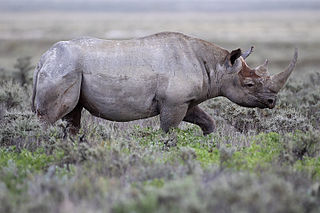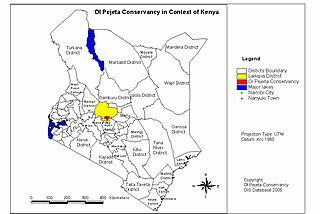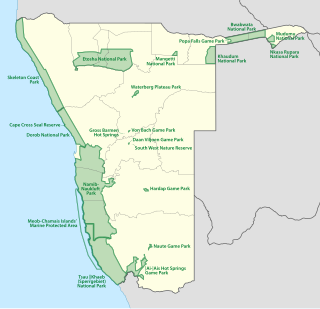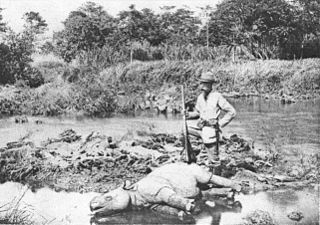Related Research Articles

Poaching is the illegal hunting or capturing of wild animals, usually associated with land use rights. Poaching was once performed by impoverished peasants for subsistence purposes and to supplement meager diets. It was set against the hunting privileges of nobility and territorial rulers.

The black rhinoceros, black rhino or hook-lipped rhinoceros is a species of rhinoceros, native to eastern and southern Africa including Angola, Botswana, Kenya, Malawi, Mozambique, Namibia, South Africa, Eswatini, Tanzania, Zambia, and Zimbabwe. Although the species is referred to as black, its colours vary from brown to grey. It is the only extant species of the genus Diceros.

A rhinoceros, commonly abbreviated to rhino, is a member of any of the five extant species of odd-toed ungulates in the family Rhinocerotidae. Two of the extant species are native to Africa, and three to South and Southeast Asia.

Trophy hunting is a form of hunting for sport in which the hunter limits its hunting to mature/old specimens holding a large set of antlers, horns or fur, common characteristics of the older male members of a huntable species, thus reducing the population impact on a huntable species, contributes to manage wildlife populations and keep genetic pool healthy, while adding value to natural habitats. Game hunted is typically a mature male specimen from a huntable species and the parts kept including horns/antlers or magnificent furs/manes are recorded to provide information about the species and habitat, also as a benchmark to determine the characteristics of animals to be hunted in a particular area. Most trophies consist of only select parts of the animal, which are prepared for display by a taxidermist. The parts most commonly kept vary by species, but often include head, skin/hide, tusks, horns, and/or antlers.
Saba Iassa Douglas-Hamilton is a Kenyan wildlife conservationist and television presenter. She has worked for a variety of conservation charities, and has appeared in wildlife documentaries produced by the BBC and other broadcasters. She is currently the manager of Elephant Watch Camp in Kenya’s Samburu National Reserve and Special Projects Director for the charity Save the Elephants.

The wildlife of Namibia is composed of its flora and fauna. Namibia's endangered species include the wild dog, black rhino, oribi and puku.

Namibia is one of few countries in the world to specifically address habitat conservation and protection of natural resources in their constitution. Article 95 states, "The State shall actively promote and maintain the welfare of the people by adopting international policies aimed at the following: maintenance of ecosystems, essential ecological processes, and biological diversity of Namibia, and utilization of living natural resources on a sustainable basis for the benefit of all Namibians, both present and future.".

The International Rhino Foundation (IRF) is a Texas-based charity focused on the conservation of the five species of rhinoceros: the White Rhinoceros and Black Rhinoceros in Africa, and the Indian Rhinoceros, Javan Rhinoceros and Sumatran Rhinoceros in Asia.
Blythe Loutit née Pascoe was a founder member of the Save the Rhino Trust (SRT), an artist and a respected conservationist.
The Wildlife Conservation Network (WCN) is a United States-based 501(c)(3) non-profit organization that protects endangered wildlife by supporting conservationists in the field who promote coexistence between wildlife and people. WCN does this by providing its partners with capital, strategic capacity-building services, training, and operational support. WCN has been given a top rating amongst wildlife conservation charities, with a four star rating on Charity Navigator.
The African Wildlife Foundation (AWF) is the leading international conservation organization focused exclusively on Africa's wildlife and wild lands.

The Sheldrick Wildlife Trust operates an orphan elephant rescue and wildlife rehabilitation program in Kenya. It was founded in 1977 by Dame Daphne Sheldrick to honor her late husband, David Sheldrick. Since 2001, it has been run by their daughter, Angela Sheldrick.

The Ol Pejeta Conservancy is a 360 km2 (140 sq mi) not-for-profit wildlife conservancy in Central Kenya's Laikipia County. It is situated on the equator west of Nanyuki, between the foothills of the Aberdares and Mount Kenya. The Ol Pejeta Conservancy works to conserve wildlife, provide a sanctuary for great apes, and generate income through wildlife tourism and complementary enterprises for re-investment in conservation and community development.

Mudumu is a National Park in Caprivi Region in north-eastern Namibia. The park was established in 1990. It covers an area of 737 square kilometres (285 sq mi). The Kwando River forms the western border with Botswana. Various communal area conservancies and community forests surround Mudumu National Park.

The Hoanib is one of the 12 ephemeral seasonal rivers in the west of Namibia, where it was the border between northern Damaraland and Kaokoland. Its length is 270 km. With the low population density, the oasis character of the river valley and the relatively high wildlife population of Hoanib, together with the Hoarusib its valley is one of the last true wilderness areas in Namibia, one of the last settlements of desert elephants and shows strong wind and water eroded and weathered stone deposits. Inflows of Hoanib are Aap River, Otjitaimo River, Ombonde, Ganamub, Mudorib and Tsuxub.

The protected areas of Namibia include its national parks and reserves. With the 2010 declaration of Dorob National Park, Namibia became the first and only country to have its entire coastline protected through a national parks network. Protected areas are subdivided into game reserves and/or nature reserves, such as special protected area, wilderness areas, natural areas, and development areas. There are also recreation reserves. Facilities in the national parks are operated by Namibia Wildlife Resorts. Over 19% of Namibia is protected, an area of some 130,000 square kilometres. However, the Ministry of Environment & Tourism auctions limited hunting rights within its protected areas. The Namibia Nature Foundation, an NGO, was established in 1987 to raise and administer funds for the conservation of wildlife and protected area management. Communal Wildlife Conservancies in Namibia help promote sustainable natural resource management by giving local communities rights to wildlife management and tourism.

The Southeast African cheetah is the nominate cheetah subspecies native to East and Southern Africa. The Southern African cheetah lives mainly in the lowland areas and deserts of the Kalahari, the savannahs of Okavango Delta, and the grasslands of the Transvaal region in South Africa. In Namibia, cheetahs are mostly found in farmlands. In India, four cheetahs of the subspecies are living in Kuno National Park in Madhya Pradesh after having been introduced there.

Khama Rhino Sanctuary is a community-based wildlife project in Botswana, located about 25 kilometres (16 mi) outside of Serowe. It covers approximately 8,585 hectares of Kalahari sandveld and is home to white and black rhinos as well as over 30 other mammal species and more than 230 species of birds. The sanctuary was established in 1992 to help save the vanishing rhinoceros and restore historic wildlife populations, as well as to develop the surrounding community. In addition to breeding rhinos, the sanctuary also has an environmental education centre, campsites, property chalets, and a restaurant onsite. Funds are mainly generated from tourism and from selling animals to other farms when capacity is exceeded on the property.

Rhinoceros poaching in southern Africa is the illegal act of slaughtering rhinoceros in the southern African countries of Namibia, Botswana, Zimbabwe and South Africa, where most of Africa's rhinos occur. The most common reason for rhino poaching is to meet the high demand for their horns in Asian countries, where the horn is predominantly used in Traditional Chinese Medicine but is increasingly being used as a symbol of wealth and prosperity. In previous generations, the most common rhino poaching activity was hunting for recreational purposes. Because of excessive poaching, rhino populations have decline rapidly since the 1970s, leaving some species critically endangered and facing extinction.

Baxu and the Giants is a 2019 Namibian 29-minute bilingual short fiction film directed by Florian Schott.
References
- ↑ Röll, Beate (2005). Huber, Bernhard A.; Sinclair, Bradley J.; Lampe, Karl-Heinz (eds.). "Variability in a Common Species: The Lygodactylus Capensis Complex from Southern and Eastern Africa (Reptilia, Gekkonidae)". African Biodiversity. Boston, MA: Springer US: 237–244. doi:10.1007/0-387-24320-8_22. ISBN 978-0-387-24320-7.
- ↑ Shivute, Basilia A. (2008). Multi-scale assessment of habitat use by Black Rhinos (Diceros bicornis Linnaeus 1758) in North West Namibia (Masters thesis).
- ↑ Owen-Smith, Garth (November 2012) [2002]. "A Brief History of the Conservation and Origin of the Concession Areas in the Former Damaraland" (PDF). In Carrington, Daisy (ed.). How Namibia Turned Poachers into Gamekeepers and Saved Rare Wildlife. Integrated Rural Development and Nature Conservation, November 2002). Vol. 23. Windhoek.